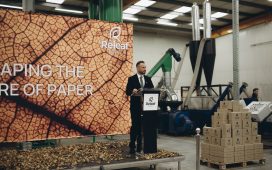One is a startup. The other is better described as an early-stage growth company. Choosing lidar maker Ouster Inc. and bus, battery and electric infrastructure provider Proterra Inc. for Securities and Exchange Commission filings scrutiny may be selective. But they represent the ongoing financial difficulties affecting companies trying to advance transportation technology.
Some have already left the stage: XL Fleet was purchased by the Shyft Group. Electric Last Mile Solutions went bankrupt amid some financial shenanigans. Romeo Power was purchased by Nikola, which is having its own financial struggles. Embark Trucks and Locomation are on the ropes and may collapse before getting back to the center of the ring.
Proterra thought SPAC was the right path to public ownership
Proterra (NASDAQ: PTRA) has disappointed Wall Street with lower-than-expected revenues, especially for a 19-year-old company that steadily built an electric bus business before getting into battery making for electric vehicles and electric infrastructure.
The company decided to fast-track its public debut via special purpose acquisition company more for the attention it could get for its newer business units than just for the $640 million it received when its SPAC with ArcVelodyneLight Clean Transportation Corp. closed in June 2021.
Former Proterra CEO Jack Allen told me two years ago that a SPAC made sense because unlike a traditional IPO, Proterra could talk up its newer businesses to investors.
“We just felt like we had a better story and that we had a story that was going to appeal to the market, no matter whether we did an IPO or whether we did a SPAC,” Allen said.
Proterra disappoints on revenue
Now, two years later, Proterra is teetering financially. It is cutting 300 jobs and combining its bus and battery making into a single operation in Greenville, South Carolina. The annual 10-K includes a strongly worded notice of going concern suggesting Proterra could default on convertible debt obligations. Unless …
The parties that loaned Proterra $150 million in August 2020 granted some grace. And that, in fact, happened on March 31, when debtors said they would extend the loans until 2028 as long as Proterra agreed to pay higher interest — 12% a year in cash and stock.
Most other covenants, including one requiring Proterra to have $125 million in cash on hand at the end of each quarter, were waived. The lenders also agreed to look the other way on Proterra’s auditor’s statement of a notice of going concern.
Even with the breathing room, Proterra expects to burn through about half of the $298 million in cash it had at the end of the year as it ramps up the Powered I plant, which Proterra expects to manufacture multiple gigawatt hours of batteries per year once fully ramped.
So there is hope. Proterra projects revenue of $450 million to $500 million in the second half based on a $1 billion backlog of minimum orders — not the high end of what customers might want. That would represent year-over-year growth of 45% to 61%.
Ouster’s stock price and market cap create pressure
Dozens of companies make some form of light detection and ranging [lidar] software. It has long been held that only a few will make it. The shakeout is underway, and Ouster Inc. appears to be on the right end, having swallowed rival Velodyne late last year.
But the market has been unkind to Ouster, which differentiates itself from other lidar companies by selling products to multiple verticals. In addition to automotive, it targets industrial, robotics and smart infrastructure.
Still, its10-K paints a negative picture of its finances. The Ouster board can call for a 1-for-5 or 1-for-10 reverse stock split at any time. That would at least temporarily help boost Ouster’s 67 cents-a-share stock price as of Thursday’s close. But it might not be sustainable, as Embark found out when it executed a 1-for-20 reverse split in August.
Ouster at risk of delisting
Ouster is at some risk of being delisted from the New York Stock Exchange, where it trades under the ticker symbol OUST. Shares have traded under $1 since March 16. The NYSE can start delisting action if a company’s shares trade for less than $1 for 30 consecutive trading days. Ouster’s trading slump could prompt its board to move on a reverse split soon.
Ouster owes $40 million to venture lender Hercules Capital, and it lists repayment as a risk. It originally had $50 million available but failed to meet some loan covenants, blocking Ouster from accessing the rest.
It sounds a bit like boilerplate language, but Ouster raises the future of lidar adoption as a separate risk.
“Given the evolving nature of the markets in which we operate, it is difficult to predict the customer demand or adoption rates for lidar technology generally or our products specifically,” according to Ouster’s 10-K filed March 24.
A timely presidential visit for Cummins
Cummins Inc. CEO Jennifer Rumsey chose Washington, D.C., to launch the rebranding of the company’s New Power segment as Accelera last month because it wanted attention it wouldn’t get with an announcement in its Midwest hometown of Columbus, Indiana.
The strategy appears to have worked. On Monday, President Joe Biden made a Cummins plant in Fridley, Minnesota, a stop on his Investing in America technology investment tour. The plant is transforming 25% of its production space there to make hydrogen-producing electrolyzers.
Rumsey didn’t make it to Minnesota for the POTUS visit. Alex Savelli, managing director of Electrolyzers Americas for Accelera by Cummins, and Amy Adams, vice president of fuel cells and hydrogen technologies, attended.
“Both of us have been at Cummins for about 30 years, and neither of us could remember a visit to Cummins by a sitting U.S. president,” Adams told me.
Cummins announced more than $1 billion in investments in three states plus $10 million in Minnesota on the day of the visit.
Briefly noted …
Speaking of making hydrogen, Plug Power Inc. reported Tuesday that it manufactured 122 megawatts of its 1MW electrolyzer stack platform in the first quarter. Plug says that’s an all-time high for the company and the industry for polymer electrolyte membrane (PEM) electrolysis.
Mack Trucks has signed a multiyear partnership with 23XI (twenty-three eleven), racing to be its official truck partner. The team is co-owned by NBA legend Michael Jordan and three-time Daytona 500 winner Denny Hamlin.
And in case you were wondering what you might do with 1 million Lego bricks, Mack Trucks Australia is planning to mark its 60th anniversary with a giant, record-breaking, Lego Mack Truck Anthem replica.
A real Mack Anthem truck takes eight days to build. The Lego version will take about two months with the project led by an official “Brick Builder.” The replica will be unveiled at the Brisbane Truck Show in May.
That’s it for this week. Thanks for reading. Click here to get Truck Tech in your email on Fridays. And tune in to Truck Tech on FreightWavesTV on Wednesdays at 4 p.m. EDT. Ouster Inc. CEO Angus Pacala and Guidehouse Insights principal analyst Sam Abuelsamid are next week’s scheduled guests.
Alan










